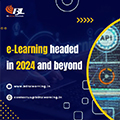
Blog
- Home
- Blog

17Feb
Why Inclusivity in eLearning Isn’t Just a Trend—It’s a Corporate Imperative in the Age of Modern Technology
Introduction
In today’s fast-paced digital landscape, eLearning has become a central component of corporate training. With advancements in modern technology, businesses are continuously seeking new ways to enhance employee development. However, one key aspect that has emerged as a non-negotiable is inclusivity. Far from being just a trend, inclusivity in eLearning has become an imperative that aligns with the core values of diversity, equity, and organizational success. In this blog, we explore why inclusive eLearning is crucial for businesses in the modern age.
The Growing Need for Inclusivity in a Diverse Workforce
As global workforces become increasingly diverse, the demand for inclusivity in training programs has never been higher. Employees come from varied backgrounds, including different cultural, linguistic, and accessibility needs. To ensure that all employees can thrive, it is essential for eLearning programs to cater to this diversity. By designing inclusive content that accommodates various learning styles, languages, and abilities, businesses create a learning environment where everyone has the opportunity to succeed.
Inclusivity goes beyond just ensuring that employees with disabilities can access learning materials. It also involves considering cultural sensitivity, making sure content is relevant and respectful to all, and offering a variety of learning formats (audio, video, text) that cater to individual preferences.
Enhancing Employee Engagement and Retention
Inclusive eLearning doesn’t just address compliance with diversity standards—it can also foster higher engagement and retention rates among employees. When employees feel valued and recognized for their unique perspectives, they are more likely to feel connected to the organization. A well-rounded eLearning program that includes accessible features such as subtitles, voiceovers, and multiple language options creates a sense of belonging and demonstrates that the company is committed to meeting the needs of all its workforce.
Engaged employees are not only more likely to complete training programs but also to apply what they’ve learned, enhancing overall productivity. Furthermore, inclusive training environments can lead to greater job satisfaction and, in turn, improve employee retention. In an era where attracting and retaining top talent is a priority, inclusivity is a critical factor in organizational success.
Legal and Ethical Considerations
Incorporating inclusivity into eLearning also has legal and ethical implications. Many countries have regulations requiring businesses to provide accessible learning experiences for all employees, including those with disabilities. The Americans with Disabilities Act (ADA) in the U.S., the Equality Act in the U.K., and similar laws in other regions mandate that digital content be accessible to all, which includes eLearning courses.
Failure to meet these requirements can lead to legal consequences, damage to a company’s reputation, and decreased morale among employees. By proactively implementing inclusive design practices, businesses ensure that they are not only compliant with relevant laws but also upholding ethical standards that align with their core values of respect and equality.
Boosting Innovation and Creativity
Inclusivity in eLearning can drive innovation by encouraging diverse perspectives. When employees from different backgrounds and experiences engage in learning, they bring unique insights that can challenge the status quo and lead to creative solutions. In fact, companies that embrace diversity tend to outperform their competitors, as diverse teams are more adept at problem-solving and generating innovative ideas.
Inclusive eLearning programs facilitate the exchange of diverse perspectives, fostering an environment that values different ways of thinking. This can result in improved collaboration, better decision-making, and a stronger ability to adapt to the changing demands of the marketplace.
The Role of Modern Technology in Enabling Inclusivity
The evolution of eLearning technology has made it easier than ever to create inclusive content. Today’s learning management systems (LMS) are equipped with a variety of accessibility features, such as screen readers, alternative text for images, and adjustable font sizes, which can be customized to meet the needs of individuals with disabilities. Additionally, AI-powered tools allow for real-time translation, personalized learning paths, and adaptive assessments, ensuring that learners from all backgrounds can engage with content at their own pace
Virtual and augmented reality technologies are also paving the way for more immersive and inclusive training experiences. These technologies can simulate real-world scenarios that cater to various learning styles, providing employees with practical, hands-on experiences regardless of their physical abilities.
Conclusion: Inclusivity as a Long-Term Investment
Inclusivity in eLearning is not just a passing trend—it’s a long-term investment that yields benefits for both employees and the organization as a whole. By designing accessible, engaging, and diverse training programs, businesses foster a positive work culture, boost employee engagement, and improve retention rates. Moreover, they position themselves as forward-thinking organizations that embrace diversity, equity, and inclusion at every level.
In the age of modern technology, businesses have the tools to make inclusivity a core part of their eLearning strategy. The time has come for companies to not only recognize the importance of inclusivity but to prioritize it as an essential component of their growth and success.

Neha Khare
About authorNeha Khare specializes in designing engaging and effective learning experiences tailored to learners' needs and also creates insightful blogs on corporate e-learning. She develops creative instructional methods, integrates multimedia, and aligns content with learning goals. Neha's innovative techniques and blog contributions significantly enhance the quality and impact of corporate training programs.



Leave a comments